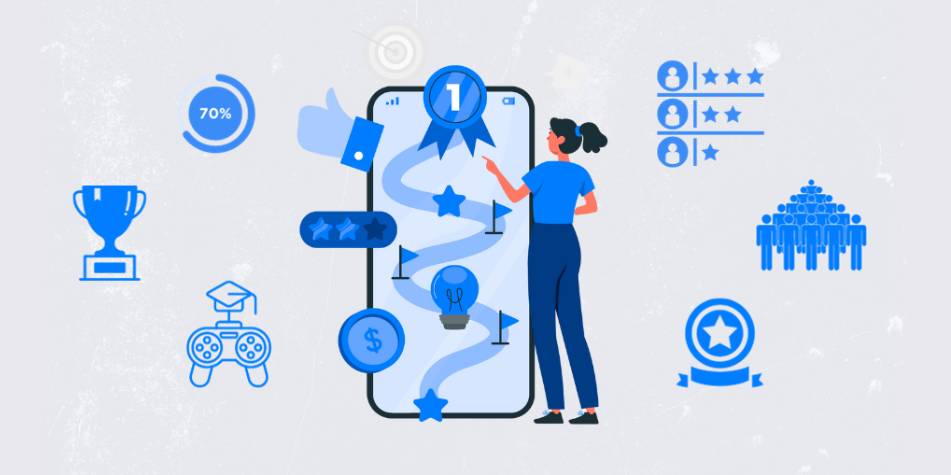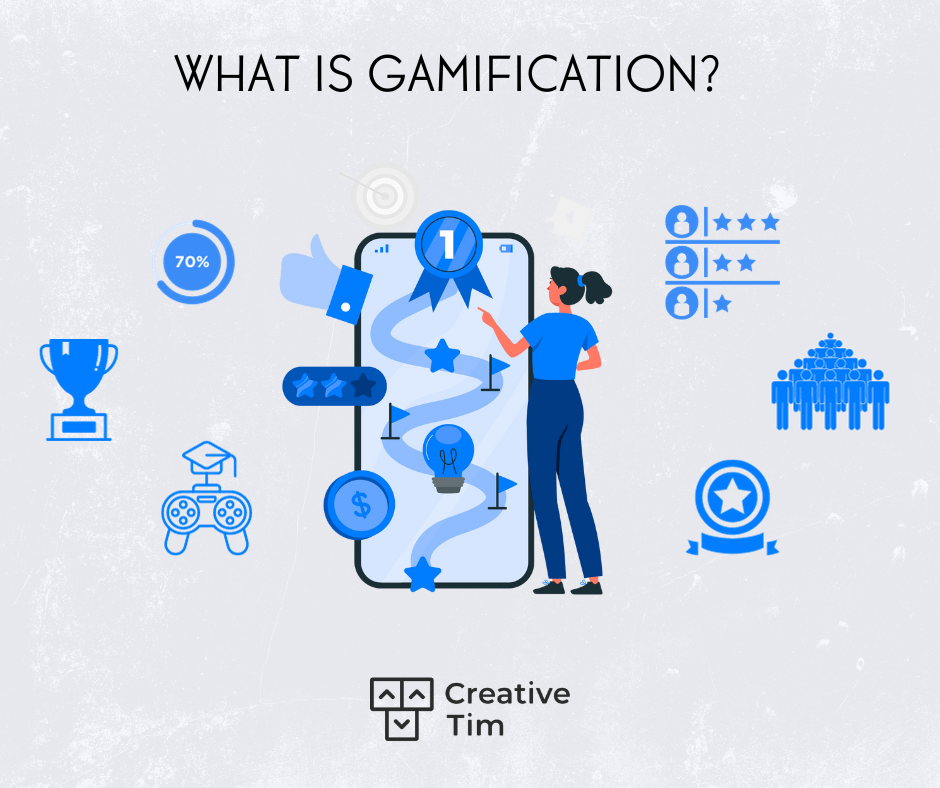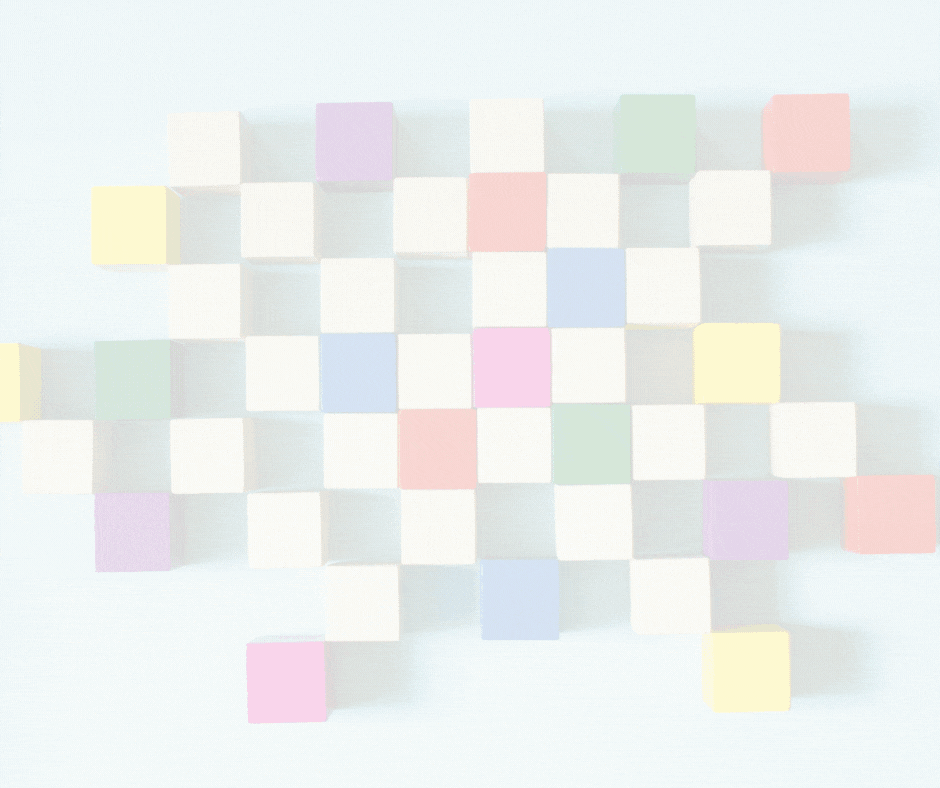
If you're into web development or web design, chances are you've come across gamification at some point.
It might sound a bit cliché, and we totally get it! But gamification isn’t just for video games, in fact, this stereotype has been shattered by countless websites across various industries.
Now, how did we get here? Who would've guessed that SaaS websites would go all-in on gamifying their platform?
That's exactly what we're here to explore! By the end of this post, you'll know what gamification is, its role in web design and, of course, some real-life examples of gamified apps.
Sounds good? Here we go!

What is Gamification
Gamification, as the name suggests, involves incorporating gaming features into websites, apps, or software (sometimes all three) into a non-game context in order to boost user engagement and get as many visitors as possible on board.
But gamifying your platform will take a little more work than just tossing in-game elements. It must fit with the brand identity of your business and communicate the message you want your audience to get.
5 Key Components of Gamification
What every business wants is a website that's not just comprehensive but also super user-friendly. To inject that sense of fun, we'll introduce you to the most common gamification components.

But here is the thing: marketing has taught us that there's no such thing as a one-size-fits-all approach. So, don't just pick one of these components at random. Instead, go for the elements that really make sense and bring some extra value to the platform.
1. Progress Bars
Sometimes, users and visitors on your website might feel a bit overwhelmed when they have to fill in lots of info step by step, and this is where progress bars help out to get them excited to hit that “continue” button!
Every time a user enters the necessary data, whether it's an image, location, a quote, or anything else, the progress bar reflects how close they are to finishing. The options for how this can be used are endless!
2. Points and Unlocks
How does your gamified system determine your users’ success on the website? Through points, of course!
When your users and clients complete specific actions on your platform, they earn points. These points help them keep track of their progress.
Many businesses that go for gamification on their websites connect points to elements like unlocks, so when users gather enough points, they get access to new bonuses and giveaways in the system.
3. Levels
Levels, also known as tiers, are a fundamental gamification element that divides a user's journey into different stages. Each level represents a different degree of achievement or progress. The idea behind this? To keep users engaged and motivated to climb that virtual ladder of achievements.
4. Leaderboards
Another component that’s very common on gamified websites is the Leaderboards. It consists in turning things into a friendly competition, where users are classified based on their achievements.
The website could also set up a time-based competition, allowing visitors to go head-to-head in a race to score the maximum possible point within a set time frame.
5. Social Sharing
Gamified experiences often include social sharing features. This can create a leveraging effect, and here’s how: Once users have a good experience and start sharing their achievements or progress, social media will do the work for you, helping you bring in fresh faces and widen your online presence.
Innovative Ways to Integrate Gamification Features on Your Website
No surprises here, but gamification can keep your visitors entertained and engaged with the content you put forward. But sorry to tell you that adding gaming mechanics isn't a simple drag-and-drop affair because every company has its own unique quirks to consider.
Looking for some inspiration on how to integrate gamification elements into your web design? Here are a few common techniques we see popular websites implementing.
Motivate Visitors to Participate
When you add game-like stuff to your business website, it naturally gets people intrigued, and it kind of makes them want to scratch the surface and see what they can do. Many folks enjoy pushing the boundaries of the game when they play.
For instance, suppose you've got a restaurant website. When customers first hop onto it, they'll see a limited menu. But as they start clicking around the options, more dishes appear, and out of curiosity, they want to find out what other dishes were added to that menu. See? Super creative.
The only potential issue with hiding content this way is that some visitors might already know what they're looking for and don't want to click through a bunch of menus. So, consider providing a simple map or skip buttons for those who just want to get straight to the point.
Customize Content for Your Audience
We don’t want you to shoot in the dark, and that’s why we suggest checking out drip campaigns. Forgive us for the jargon! In simple terms, these are just marketing strategies where seasoned marketers create campaigns based on user profiles and archetypes.
Creating user profiles for your target audience makes it a no-sweat for you when designing game elements, as you already know what hits the mark for each customer type. Not only does this allow you to customize your elements, but it also guarantees that nothing gets missed out.
Spread The Word on Social Media
As we touched on in the previous section, humans are naturally sociable, and gamification is a fantastic way to take that social aspect to a whole new level.
One savvy move many companies make is setting up a loyalty program that rewards repeat purchases with points and levels.
Once the results pop up online, participants will do the word-of-mouth magic recommendation across their social media circles, and that's when your brand's visibility will skyrocket.
Consider adding some shareable boards on your website. It's a fantastic way for users to check out competition results, interact with each other, and spread the word.
Marry Learning and Fun
Our minds are naturally curious, and that sense of joy in discovering something new never gets old. People are always eager to explore and learn, and what could be a more fun way to capitalize on this feeling than through games?
While it might sound like a cliché, the onboarding system is the perfect example of this practice:
- Offer visitors a challenge.
- Equip them with the tools they need to tackle it.
- Let them experiment.
- When they succeed, give them a reward.
This method will attract different types of customers. Some will go the extra mile and explore every option, while others will kick back and enjoy their time on the website, gradually making progress with each visit.
Gamify with moderation
Please don't go overboard with gamifying your whole platform; otherwise, it's going to be too much of a good thing! Yep, you heard it right. Because, at the end of the day, you're not offering a full-blown game to your users here.
Instead, make sure to incorporate game elements that speak their language and grab their attention without overwhelming them. Don’t forget that they are looking for high-quality content that hits their pain points and provides real solutions in the first place.
The Role of Gamification in Web Design
Now that you know what goes into the gamification elements and how to incorporate them on your website, it's time to dive deeper and give you compelling reasons why gamification is your one-stop solution to boost user engagement.
Ready to explore? Let's jump right in!

Enhanced User Experience
When your website offers an exceptional user experience, there's a great chance the conversion rate will go through the roof. But revenue isn't really the whole story.
So what's the end result of all this? A top-notch UX design encourages your customers to share their incredible journey with others, and this will create a ripple effect of word-of-mouth growth that keeps bringing in more organic traffic to your website. Pretty cool, right?
Data Collection and Personalization
Gamification can be your best bet for collecting valuable user data, and it's not hard to see why! As visitors engage and have fun with the interactive content you've put on your website, you can easily gather insights about their preferences and behaviors through channels like online surveys, quizzes, and progress tracking… you name it.
After collecting that data, the next step is to organize it to optimize your content and product recommendations. This way, you can help with all of the challenges your users and potential customers are struggling with. Two goals with a single shot!
Building Community
Things like game elements, challenges and user profiles are powerful enough to create a sense of community among your website's visitors.
Now, think about it – when users compete with each other, team up on missions, or share their achievements on social media, a sense of belonging and teamwork starts to take shape, and this can magically transform your casual visitors into loyal community members.
User Retention
You probably know that our brains are wired to enjoy rewards and recognition. But you might be wondering, 'How does this connect to gamification?' Well, the whole point of gamification is to motivate people to keep coming back by offering incentives and giveaways.
This way, your user base, including customers in the sales process, will consistently return to your website and engage with the content you have to offer.
Competitive Advantage:
If your industry hasn't jumped on the gamification bandwagon yet, you've got an unmissable opportunity to get that first-mover advantage. After all, what you really want is a website that's not just comprehensive but also engaging and super user-friendly.
This step will take the engagement on your website to a whole new level. And the cherry on top? It’s going to set you apart from the curve—all thanks to the enjoyable user experience you provide to your visitors.
6 Amazing Examples and Use Cases of Gamification in Web Design
As you probably know, gamification is no longer a new thing. Many websites across the internet have been using this approach, and chances are, you've come across a few without even realizing they're gamified platforms.
In this section, we’ll explore the most eye-catching examples and use cases you can find on the web.
Enough talk. Let’s get hands-on!
1. LinkedIn

LinkedIn is the world's largest networking hub, and connecting is the name of the game! But have you ever noticed how it encourages users to fill out their profiles? It implements a well-thought-out mechanic design, treats each section of your profile as a little achievement, and shows you a progress bar to track how complete your profile is.

It’s designed to trigger your completionist instinct, and there's a reason behind it. The people who have a fully filled-out profile on LinkedIn are perceived to be better networkers.
2. Habitica

Habitica is a habit tracker and a productivity booster that combines role-playing game mechanics and applies game design to incentivize you to track and complete daily habits.
You start by picking a character with a health and experience bar, and from there, you can create habits, set daily tasks and manage your projects.
When you check off a task or complete a project, you get rewarded with experience, virtual receipts and gold that allow you to buy items and equipment to customize your character.

But that’s not all. It has this awesome guilt feature where you can join a group and take on challenges together. The community sets challenges for everyone to complete daily, weekly, or monthly, and if one of the members skips out on the habit, the whole team will lose alike, just like letting your team down in a game.
3. Todoist

Todoist has a neat yet engaging interface that allows users to list their ongoing tasks and check them off upon completion. But the killer feature that sets Todoist apart is the goal visualization.

Todoist offers karma rewards based on the user’s productivity. Not only that, Todoist also offers a quiz for their customer base to help them figure out the best way to approach their tasks and goals.
4. Forest

Forest is a productivity app (a browser extension as well) that uses something called the Pomodoro technique to keep you on track and away from your phone's distractions by planting your virtual tree that grows the longer you stick with your task and stay in the app.
You can also set your own timer if you want to concentrate for a specific amount of time, but as soon as you leave the app with time left on the clock, your tree dies.

Forest took their unique concept to the next level by giving users the chance to earn and use virtual coins for a real-world cause – planting trees.
So, we can assume that you’ve got a digital buddy keeping you on track, right?
5. Reddit

If there is one website in this list that had gamification from the get-go, Reddit takes the cake. This site is made up of user-submitted content in the form of links, images, videos and text posts, and the community is responsible for curating and organizing the content.
When X user submits a post, others can upvote it or downvote it, and the most popular posts rise to the top of their respective subreddits while the ones with fewer upvotes end up lower down.
This creates a super competitive environment where users are constantly vying for that top spot, which results in keeping users engaged and active on the platform.

And if you thought that's all, gear up! Every Reddit user has a Karma score that rates their profile's comment and post quality, all based on those upvotes and downvotes we just talked about.
6. Grammarly

Grammarly is a writing assistant that students, writers, and other professionals can use to proofread and edit their documents.
What's cool about Grammarly is that it doesn't just fix typos. It offers you all sorts of helpful info, like stats and auto-suggestions, to encourage you to improve and fine-tune your writing scores.

It even comes with a built-in plagiarism checker that lights up like a little animated lamp when your text is 100% original.
Your Turn
And that’s it from us, phew! We hope you had as much fun reading this article as we did writing it!
We can safely say that we have told you as much about gamification as you should know before you incorporate it into your online platforms.
Now, just reading it isn't enough, Right? Get your hands muddy, gamify your platforms, and reap the benefits that come with it.
Oh, and while you're at it, why not give Creative Tim a shot? Go ahead, It's just a click away!
Author Bio:
Amine Boussassi is a marketing manager at Hustler Ethos, He is enthusiastic about productivity, project management tools, and everything in between. His overarching mission revolves around empowering companies to achieve high rankings on Google.